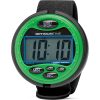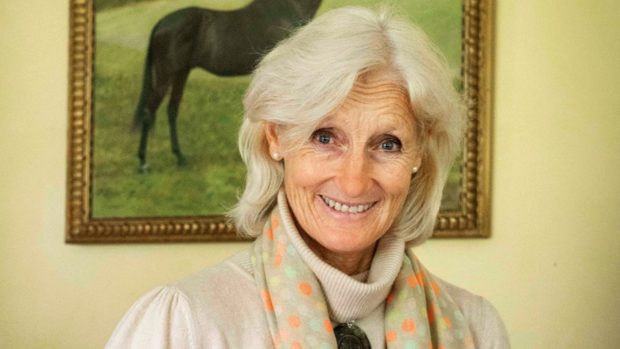Riders are allowed to wear a stopwatch for the cross-country phase at all levels in British Eventing (BE) competitions, but it is not compulsory to do so.
Whether you choose to pop on a stopwatch will be governed by your experience, your horse’s age and experience and your aims for the day – and personal preference. Some riders like to ride on feel alone at one-day events. Younger or inexperienced riders may be advised by a coach to focus on getting the jumping right first without the distraction of wearing a watch and trying to ride to time. And competitors on a young horse will probably want to prioritise his experience round the course over competitiveness, so may well not wear a watch.

Optimum Time OE Series 3 Event Watch | Amazon.co.uk
Available in 7 colours, this watch is what every eventer needs. It comes on an elasticated strap, gives minute beep signals and has a 16mm display with an adjustable viewing angle.
Wearing a stopwatch: top rider and coach views
By Sue Polley
‘No advantages to wearing a stopwatch’
“In my view there are no advantages to wearing a stopwatch at the lower levels,” says coach Jonathan Chapman, a British Horse Society Instructor (BHSI). “Riding is about feel and it is better to get a few time-penalties and gradually increase your speed – this will often happen naturally as the partnership becomes more confident rather than forcing it from the outset.”
‘Balance within the pace is more important’
Jeanette Brakewell is another coach and rider who stresses the importance of feel and balance within whatever pace a horse is travelling at, rather than pace for pace’s sake: “The correct pace is important but crucially the balance within the pace is more important,” she says.
“A stopwatch can be a good guide as to whether the rider is at the correct pace for the level they are at and then to identify safe ways to make up time at their next competition. Conversely it could encourage riders to slow down if they have been too fast. Wearing one at BE100 level would give riders a good gauge of where they are at if they are looking to step up to novice level.”
Jeanette never wears a stopwatch at all until a three-day event as she prefers to ride to how the horse feels.
The YES camp
Eventer and BE-accredited coach Mark Corbett feels it is appropriate to wear a stopwatch at any level with the proviso that the rider’s base level of jumping competence is good enough.
“I think stopwatches help riders understand the rhythm they need to be in, regardless of the level they are at,” says Mark.
“However, possible problems are that those using them may focus too much on time and not enough on their jumping. This can be addressed by practice and education though. Grassroots riders should definitely think about using them in training and on the gallops if they are contemplating using one at competitions. Even then, they should only do so when they know their jumping competence and training are good enough.”
Former British young rider team trainer Emma Fisher also acknowledges that stopwatches can actually be a good training aid, saying: “They can be useful to use on the gallops and to practise riding at a certain pace between two fixed points.”
Watches can also prove very handy to record the time if you get stopped on course and as a way of monitoring pace. However, the key to ultimately achieving the cross-country time, regardless of the level you are riding at, is to ride tight lines, move away from your fences quickly, get your horse in a consistent rhythm and interfere as little as possible – not by racing against a ticking watch.

Optimum Time OE Series 3 Event Watch | Amazon.co.uk
Available in 7 colours, this watch is what every eventer needs. It comes on an elasticated strap, gives minute beep signals and has a 16mm display with an adjustable viewing angle.
View from a grassroots rider
By H&H eventing editor Pippa Roome
I event at BE80 and BE90 level on a 15.1hh Connemara and I do wear a stopwatch. I absolutely agree that riders need to prioritise jumping the fences – for both safety and competitive reasons – before speed, but I also believe that to be consistently competitive at grassroots, you need to wear a stopwatch and learn to ride to time.
Of course a lot depends on your own horse and your natural speed as a partnership, but the way the time comes up on different courses varies a lot according to how tight the route has been measured and what the track is like in terms of fences and terrain. As such, if you want to ensure you’re within the 15-second penalty-free window, wearing a watch is necessary.
In general, I need to keep moving on to make the time at BE90 level – I’m riding a smaller horse, who is not naturally speedy, and wearing a watch and riding to minute markers means I have reminders to keep up to speed. I don’t always ride to make the time, of course. If I’m not in a competitive position, I will take things a little easier, but I actually need to ride at around that pace to give the right determination and flow to a round, so it’s still useful to wear a watch, even if I’m happy to accept a few time-faults.
I have, though, ridden the odd course where I can very comfortably make the time and have received too-fast time-faults once. Now that I have a little more experience of wearing a stopwatch and riding to minute markers, I like to think I could avoid this – while also avoiding the sanctions which can be given out for dramatically changing your pace at the end of a course to avoid too-fast faults.
I think riding with a stopwatch effectively is much easier now that pretty much every course is on CrossCountry App with minute markers. It’s unlikely anyone will wheel the course themselves at a grassroots one-day event – you really need to do a separate course-walk for that to the one you do to suss out the jumps, which there’s rarely time for. But you can find the minute markers on CrossCountry App and I make sure I note them as I walk the course and so generally have four checks on how I’m doing on time as I ride the course.
I’ll also think after walking the course about whether some minutes are likely to be slower – for example if they have a lot of jumping or combinations that I need to set up for in them – and take that into account as I ride, so I wouldn’t panic if those slower sections took a bit over 60 seconds. I’d plan to make up the time in the parts with more galloping stretches.
I use the watch in count down mode – I set it to 10 seconds over the optimum and press go when the starter gives me the 10-second prompt. If you’re riding to minute markers, you need to work those into your planning – so if the optimum time is 4min 45sec, you need to be at one minute at 3min 45sec, at two minutes at 2min 45sec and so on. In some ways, it’s easier to have your watch counting up – then the minute markers come up at one minute, two minutes etc, but I once got terribly confused about what the optimum time was on course, so count down does avoid this. Different methods will suit different people.
Beeper on or beeper off is something else to consider. I prefer to ride with the beeper off as I have occasionally found it distracting to have it sounding on the approach to a fence and I don’t struggle to look at the watch face, so I don’t need the audio prompt.
You might also be interested in:

Nine secrets of successful cross-country from Tim and Jonelle Price

How often does Tom McEwen go cross-country schooling? Do his horses wear studs for it? Find out here…

How to retrain a strong horse so you can slow down and stop in a snaffle

‘You can self coach’ – how to improve your riding without lots of lessons

Subscribe to Horse & Hound this spring for great savings
Horse & Hound magazine, out every Thursday, is packed with all the latest news and reports, as well as interviews, specials, nostalgia, vet and training advice. Find how you can enjoy the magazine delivered to your door every week, plus options to upgrade your subscription to access our online service that brings you breaking news and reports as well as other benefits.




